Heavy.com; By Shannon Walsh; July 11, 2016; Updated December 4, 2016
In July of 2016, History Channel aired its new documentary, DB Cooper: Case Closed, in which a team of investigators revealed who they believe is responsible for the notorious hijacking of a Boeing 727 in 1971. He is Robert W. Rackstraw Sr., a 73-year-old retired university instructor and arbitration expert, now living in San Diego, California.
The team’s findings and alleged evidence are also featured in an investigative book, The Last Master Outlaw. But just who is Robert Rackstraw? What do we know about him, and could he be responsible for one of the most famous cold cases in history?
Read on to find out.
1. He Had an Illustrious Military Career

Rackstraw was a Vietnam veteran with elite military training. He was in the National Guard, the Army Reserve, the Regular Army, and went to Vietnam in 1969 with the 1st Cavalry Division, which is one of the most decorated combat divisions in the US Army. During his military career, Rackstraw climbed the ranks as a Private, Sergeant, Corporal, and eventually became a First Lieutenant.
Don Ray, an accomplished journalist and archivist featured in History Channel’s documentary, is an expert in public records. In the premiere night, he gave detailed accounts of Rackstraw’s accomplishments. “When I took a look at the copies of his file, I remember shaking my head and saying, ‘Woah, I’ve never seen one that had so much in it.’”
2. He Was Identified as a Suspect in 1978
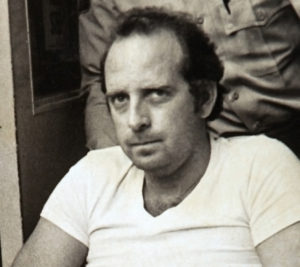
In 1978, seven years after the hijacking, Rackstraw was first identified by the FBI as a potential suspect in the case. Then Stockton Detective Sgt. Charles Buck and Fire Department Arson Investigator Michael Murray submitted Rackstraw’s name as a potential suspect “because there were so many things that seemed to fit,” according to a February 3, 1979 Stockton Record news article.
In 1979, TV Reporter Warren Olney of KNBC spoke to Rackstraw, and asked him: “Are you willing to state one way or the other whether or not you’re DB Cooper?” According to the station’s archived video, Rackstraw responded: “Uh, I’m afraid of heights [smiling].”
Olney pressed Rackstraw further for details: “You have parachute training and, and uh, as you mentioned yourself, your background suggests that you could have been DB Cooper.” Rackstraw responded, “Could have been, could have been.”
3. He Was Released From the Army in 1971
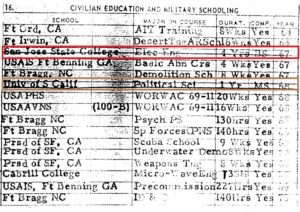
Rackstraw was forced to resign from the military in 1971 because he had lied about attending two separate colleges when, in fact, he was a high school dropout.
For cold-case organizer Tom Colbert and his investigative reporter, Jim Forbes, this forced resignation explained Rackstraw’s motive. In the documentary, Forbes states, “He’s been in the army for 7-plus years. It’s the first thing he’s had stability in his life, and it’s suddenly snatched from him.”
4. He Attended Jump School

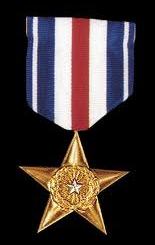
During his military career, Rackstraw attended the US Army Airborne School at Ft. Benning, Georgia, otherwise known as Jump School. For Forbes and Colbert, that suggests he would have had the means of carrying out the hijacking and parachuting that DB Cooper is notorious for.
Rackstraw also attended helicopter school, and among his many achievements, he received two Distinguished Flying Crosses (military aviation’s highest medal) and a Silver Star. When discussing the former Lieutenant’s time in service, cold case team member Ray said, “This guy was amazing. It’s like he found the way to go to every possible school you could go to.”
5. His Photograph Closely Resembles the FBI’s Composite Sketch
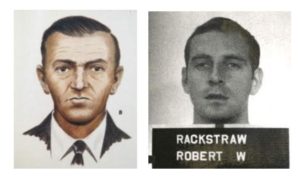
Cold case investigators located many pictures of Rackstraw – including an ID photo from 1970 Army archives, which the FBI requested a copy (above). One picture from relatives was taken a year before the November 24, 1971 hijacking, and another just a month before. All three bear an uncanny resemblance to the FBI’s Cooper facial composite Sketch #2. Tom Colbert reveals this sketch was considered the most accurate, as it came from the testimony of a nearby passenger, who like others, was not told of the ongoing bombing plot. At the time, the passenger was a university sophomore and he sat directly across from Cooper on the plane.
Producers of the documentary tracked down this passenger, then presented him with several potential suspect photos – he immediately pointed at Rackstraw’s.
In Chapter 20 of The Last Master Outlaw, state investigator Jay C. Todd says, “If you compare the sketch to Rackstraw’s 1970 Army picture, there are nine absolute points of match – in the brown eyes, ears, noses, short mouths, frown lines, chins, brows, odd head shapes, and male-pattern baldness. Frankly, it looks like Mitchell’s sketch was traced from his photo.”
But when producers gave a handful of Rackstraw pictures to the flight attendant who sat next to Cooper, she failed to recognize him. Two former FBI agents who interviewed this attendant in the 1980s, however, told the media and authors that they believe the flight attendant suffered from permanent traumatic memory loss from the ordeal.
##
Also available: Cold Case Team’s 102 evidentiary facts, and the investigation’s key supporting materials (historic articles, photos, judiciary documents, military records, charts, theory summaries and maps).
http://heavy.com/news/2016/07/robert-rackstraw-db-cooper-case-closed-documentary-culprit-who-is/



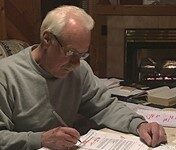
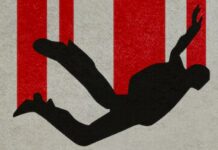



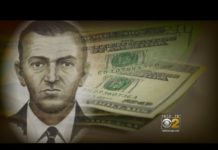
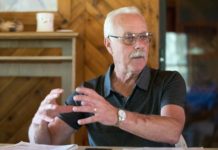



Buck Ass Wild, Hell Yeah
Look one way while I go the other